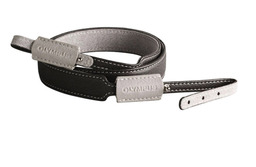My history with camera straps goes all the way back to those skinny leather "neck cutters" that were standard issue with our film cameras. You can imagine my joy when Canon and others developed the wider, softer fabric models that were more comfortable and were included with their SLRs.
This Olympus E-Z Adjustable Camera Neck Strap runs $15 and is a handsome, lightweight solution for street shooters who like to keep their hands free.
But over the years, I tired of long, tangly straps all together and experimented with shorter wrist models. These were even more practical with lighter digital cameras such as the micro four thirds that I often shoot with today.
Unfortunately, they weren't perfect either. If your camera is bound to one hand, then you really only have the other free. And suddenly I was looking for a place to set the camera down when I needed both hands to work on something.
What I've finally discovered, after all of these years, is that camera straps are like camera bags, and it's unlikely that just one is going to be perfect in every situation. Why this took me so long to figure out, I don't know.
I use a Gariz Leather XS-WB1 camera hand strap on the OM-D E-M5 Mark II, which is the camera most likely to end up on a tripod.
I carry two cameras in my everyday bag. My street shooter, a black Olympus OM-D E-M10, is configured with a neck strap that allows me to keep my hands free and the camera ready for a quick shot when opportunity presents itself. I can carry the E-M10 a variety of ways, including hiding it beneath my jacket when necessary. Hands are always free.
My other camera, the OM-D E-M5 Mark II sports a wrist strap. That's because it's most likely to end up on a tripod for a 40MP high rez image, an HDR, or panoramas. The wrist strap stays out of the way and doesn't get tangled up with the other gear. Plus, there are times I just don't want the long, dangly neck strap to deal with.
And there are dozens of other solutions, many of which you probably use, or may have tried. Regardless of which particular type of strap you like, chances are good that it works better in some situations than others. So, when it's all said and done, the likely solution is that two straps are better than one.
Want to Comment on this Post?
You can share your thoughts at the TDS Facebook page, where I'll post this story for discussion.












